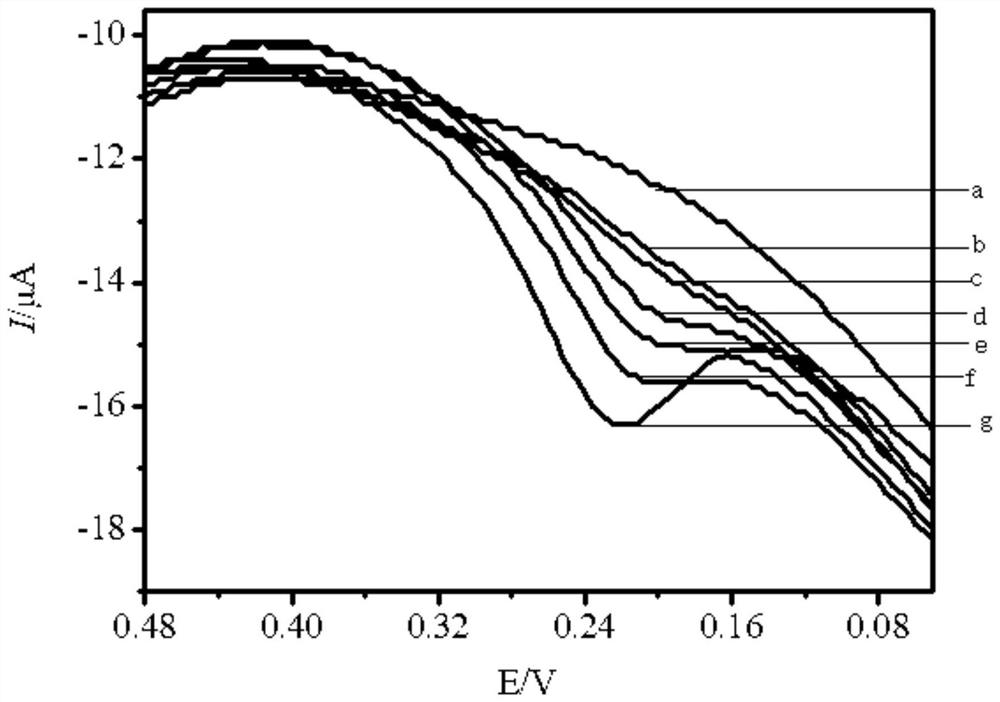Detection method of dopamine concentration
A detection method and technology of dopamine, applied in nano-carbon, graphene, material electrochemical variables, etc., can solve the problems of high cost, application limitation, poor stability of Pt catalyst, and achieve improved electron transfer rate, low detection limit, The effect of improving stability
- Summary
- Abstract
- Description
- Claims
- Application Information
AI Technical Summary
Problems solved by technology
Method used
Image
Examples
Embodiment 1
[0029] A method for detecting dopamine concentration, comprising:
[0030] Step 1, preparing aminated reduced graphene oxide and Pt-Au bimetallic modified glassy carbon electrode;
[0031] Step 2, preparing PBS buffer solutions of different concentrations of dopamine;
[0032] Step 3. Use the prepared aminated reduced graphene oxide and Pt-Au bimetallic modified glassy carbon electrode as the working electrode to form a three-electrode system, wherein the auxiliary electrode is a Pt electrode, and the reference electrode is an Ag / AgCl electrode. The three-electrode system is put into the PBS buffer solution of dopamine in turn, and the PBS buffer solution of dopamine is detected by differential pulse voltammetry, and the differential pulse voltammetry curves corresponding to the PBS buffer solutions of different concentrations of dopamine are obtained, and established The relationship equation between dopamine concentration and current intensity;
[0033]Step 4, adding the d...
Embodiment 2
[0041] On the basis of Example 1, in step b, before modifying the pretreated glassy carbon electrode with amination reduction graphene oxide, it also includes dropping 5 μL of cerium / dioxide on the surface of the pretreated glassy carbon electrode with a pipette gun. Silicon dispersion, placed in a GJ-1A type infrared rapid drying oven to dry for 20 minutes and then taken out, cooled to room temperature, the preparation method of the cerium / silicon dioxide dispersion is: dissolve 0.5gCe(NO3)3·6H2O in 100ml of deionized water, then add 25g of nano silicon dioxide, after fully stirring, let it stand for 24h, then transfer to a vacuum drying oven, dry at 100°C for 14h, then transfer to a muffle furnace, at a heating rate of 15°C / Raise the temperature to 300°C for 10 minutes, then raise the temperature to 500°C at a heating rate of 5°C / min, and hold for 2 hours. After cooling, take it out, dissolve it in 50ml of deionized water, and process it ultrasonically for 10 minutes.
[00...
Embodiment 3
[0044] On the basis of Example 2, it also includes, after step c, putting the aminated reduced graphene oxide and the Pt-Au bimetallic modified glassy carbon electrode into a magnetizer for magnetization treatment, specifically: first place the The aminated reduced graphene oxide and Pt-Au bimetallic modified glassy carbon electrodes were treated at a magnetic field strength of 10T for 10 minutes, then at a magnetic field strength of 14T for 15 minutes, and finally at a magnetic field strength of 20T for 15 minutes.
[0045] The detection limit of dopamine for the aminated reduced graphene oxide and Pt-Au bimetallic modified glassy carbon electrode prepared in this example is 4.7×10 -8 mol / L.
PUM
 Login to View More
Login to View More Abstract
Description
Claims
Application Information
 Login to View More
Login to View More - R&D
- Intellectual Property
- Life Sciences
- Materials
- Tech Scout
- Unparalleled Data Quality
- Higher Quality Content
- 60% Fewer Hallucinations
Browse by: Latest US Patents, China's latest patents, Technical Efficacy Thesaurus, Application Domain, Technology Topic, Popular Technical Reports.
© 2025 PatSnap. All rights reserved.Legal|Privacy policy|Modern Slavery Act Transparency Statement|Sitemap|About US| Contact US: help@patsnap.com


